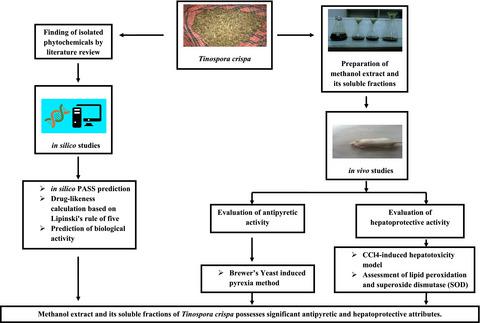当前位置:
X-MOL 学术
›
Food Sci. Nutr.
›
论文详情
Our official English website, www.x-mol.net, welcomes your
feedback! (Note: you will need to create a separate account there.)
Antipyretic and hepatoprotective potential of Tinospora crispa and investigation of possible lead compounds through in silico approaches.
Food Science & Nutrition ( IF 3.5 ) Pub Date : 2019-12-23 , DOI: 10.1002/fsn3.1339 Ahmed Rakib 1 , Shahriar Ahmed 1 , Md Ashiqul Islam 1 , Abdul Haye 2 , S M Naim Uddin 1 , Mir Muhammad Nasir Uddin 1 , Mohammed Kamrul Hossain 1 , Arkajyoti Paul 3, 4 , Talha Bin Emran 3, 5
Food Science & Nutrition ( IF 3.5 ) Pub Date : 2019-12-23 , DOI: 10.1002/fsn3.1339 Ahmed Rakib 1 , Shahriar Ahmed 1 , Md Ashiqul Islam 1 , Abdul Haye 2 , S M Naim Uddin 1 , Mir Muhammad Nasir Uddin 1 , Mohammed Kamrul Hossain 1 , Arkajyoti Paul 3, 4 , Talha Bin Emran 3, 5
Affiliation

|
This research describes an investigation of the antipyretic and hepatoprotective properties of both a crude organic extract and various subfractions of the ethnomedicinal plant Tinospora crispa, using appropriate animal models. In an attempt to identify potential lead hepatoprotective compounds, in silico experiments were utilized. Antipyretic activity was assessed via the Brewer's yeast‐induced pyrexia method, while hepatoprotective effects were evaluated in a carbon tetrachloride (CCl4)‐induced animal model. A computer‐aided prediction of activity spectra for substances (PASS) model was applied to a selection of documented phytoconstituents, with the aim of identifying those compounds with most promising hepatoprotective effects. Results were analyzed using Molinspiration software. Our results showed that both the methanol extract (METC) and various subfractions (pet ether, PEFTC; n‐hexane, NHFTC; and chloroform, CFTC) significantly (p < .05) reduced pyrexia in a dose‐dependent manner. In CCl4‐induced hepatotoxicity studies, METC ameliorated elevated hepatic markers including serum alanine amino transferase (ALT), aspartate amino transferase (AST), alkaline phosphatase (ALP), and total bilirubin. Malondialdehyde (MDA) levels were significantly reduced, while superoxide dismutase (SOD) levels were significantly increased. Among a selection of metabolites of T. crispa, genkwanin was found to be the most potent hepatoprotective constituent using PASS predictive models. These results demonstrate that both the methanolic extract of T. crispa and those fractions containing genkwanin may offer promise in reducing pyrexia and as a source of potential hepatoprotective agents.
中文翻译:

卷叶青牛胆的解热和保肝潜力以及通过计算机方法研究可能的先导化合物。
本研究描述了使用适当的动物模型对粗有机提取物和民族药用植物春牛胆的各种亚组分的解热和保肝特性进行的研究。为了鉴定潜在的先导保肝化合物,采用了计算机模拟实验。通过啤酒酵母诱导的发热法评估解热活性,同时在四氯化碳 (CCl 4 ) 诱导的动物模型中评估保肝作用。将计算机辅助物质活性谱预测 (PASS) 模型应用于精选的已记录植物成分,目的是识别那些最有希望具有保肝作用的化合物。使用 Molinspiration 软件分析结果。我们的结果表明,甲醇提取物 (METC) 和各种亚组分(石油醚,PEFTC;正己烷,NHFTC;和氯仿,CFTC)均以剂量依赖性方式显着 ( p < .05) 减少发热。在 CCl 4诱导的肝毒性研究中,METC 改善了升高的肝脏标志物,包括血清丙氨酸氨基转移酶 (ALT)、天冬氨酸氨基转移酶 (AST)、碱性磷酸酶 (ALP) 和总胆红素。丙二醛(MDA)水平显着降低,而超氧化物歧化酶(SOD)水平显着升高。使用 PASS 预测模型发现,在卷草的一系列代谢物中,芫花素是最有效的保肝成分。这些结果表明,卷草的甲醇提取物和含有芫花素的那些级分可能有望减少发热并作为潜在的保肝剂的来源。
更新日期:2019-12-23
中文翻译:

卷叶青牛胆的解热和保肝潜力以及通过计算机方法研究可能的先导化合物。
本研究描述了使用适当的动物模型对粗有机提取物和民族药用植物春牛胆的各种亚组分的解热和保肝特性进行的研究。为了鉴定潜在的先导保肝化合物,采用了计算机模拟实验。通过啤酒酵母诱导的发热法评估解热活性,同时在四氯化碳 (CCl 4 ) 诱导的动物模型中评估保肝作用。将计算机辅助物质活性谱预测 (PASS) 模型应用于精选的已记录植物成分,目的是识别那些最有希望具有保肝作用的化合物。使用 Molinspiration 软件分析结果。我们的结果表明,甲醇提取物 (METC) 和各种亚组分(石油醚,PEFTC;正己烷,NHFTC;和氯仿,CFTC)均以剂量依赖性方式显着 ( p < .05) 减少发热。在 CCl 4诱导的肝毒性研究中,METC 改善了升高的肝脏标志物,包括血清丙氨酸氨基转移酶 (ALT)、天冬氨酸氨基转移酶 (AST)、碱性磷酸酶 (ALP) 和总胆红素。丙二醛(MDA)水平显着降低,而超氧化物歧化酶(SOD)水平显着升高。使用 PASS 预测模型发现,在卷草的一系列代谢物中,芫花素是最有效的保肝成分。这些结果表明,卷草的甲醇提取物和含有芫花素的那些级分可能有望减少发热并作为潜在的保肝剂的来源。










































 京公网安备 11010802027423号
京公网安备 11010802027423号